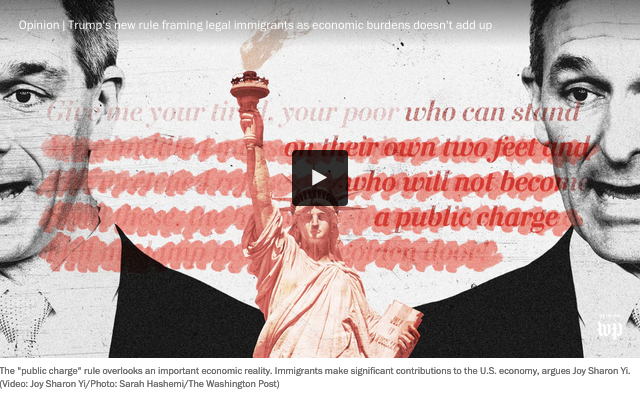In announcing a controversial new policy designed to prevent immigrants from becoming a burden to taxpayers, Trump administration officials said they were trying to uphold the very American principle of self-sufficiency. Ken Cuccinelli, acting director of U.S. Citizenship and Immigration Services, went so far as to claim that the new rule clarifies the meaning of the famous Emma Lazarus poem on the Statue of Liberty. He told NPR last month that the motto is best summarized as, “Give me your tired and your poor who can stand on their own two feet and who will not become a public charge.”
There has long been a provision in immigration law designed to weed out applicants for citizenship who are likely to become dependent on the state — to become “public charges,” in officialese. The previous rule focused on whether immigrants made use of public cash assistance, including Temporary Assistance for Needy Families, or required subsidized long-term care. The new rule radically expands the list of programs that legal immigrants can be penalized for using to include food stamps, Medicaid and housing vouchers, among other things.
Yet the new strictures, set to go into effect Oct. 15, if lawsuits challenging them fail, are based on a false premise. They reflect an outdated assumption that native American workers ought to be, and largely are, self-sufficient (exceptional periods of hardship aside) and so immigrants should meet that standard, too. But reliance on public benefits has become a fact of life for a large swath of American workers, immigrants and nonimmigrants alike, because the past 40 years — thanks to global economic shifts, tax policies, technology, waning union power and the prioritization of corporate profit over wages — have remade American work.
The inadequacy of many working-class jobs today exposes the cruelty of the rule. If people who use food stamps count as public charges — as burdens on the economy — then lots of hard-working Americans, regardless of citizenship status, fall into that category.
A 2016 study by the Economic Policy Institute, for instance, found that, once the elderly are excluded, more than 70 percent of all public safety-net beneficiaries — including those who receive Medicaid, food stamps, housing aid and cash assistance — are working families or individuals, not unemployed people. Nearly half the recipients of such benefits work full time. A 2015 study, by researchers at the University of California at Berkeley’s Center for Labor Research and Education, found that the United States spends almost $153 billion every year on benefits for workers, most of them employed full time, and that the people who need government aid to survive include employees of large, profitable corporations such as McDonald’s, Walmart and Amazon (Jeff Bezos, the chief executive of Amazon, owns The Washington Post). The study found that about half of fast-food workers, child-care workers and home health aides relied on public benefits — as did a quarter of part-time college faculty members. In New Hampshire, Iowa, Texas, Oklahoma, Colorado, Hawaii, Utah and Nebraska, more than 60 percent of all public assistance went to working families, the study found.
Balancing Paychecks and Public Assistance
Key findings include:
- Most recipients of public assistance work or have a family member who works.
- Among families or individuals receiving public assistance, the majority (66.6 percent) work or are in working families (families in which at least one adult in the household works). This number grows to 71.6 percent when focusing on non-elderly recipient families and individuals (those under age 65).
- About 69.2 percent of all public assistance benefits received by non-elderly families or individuals go to those who work.
- Nearly half (46.9 percent) of all working recipients of public assistance work full time (at least 1,990 hours per year).




